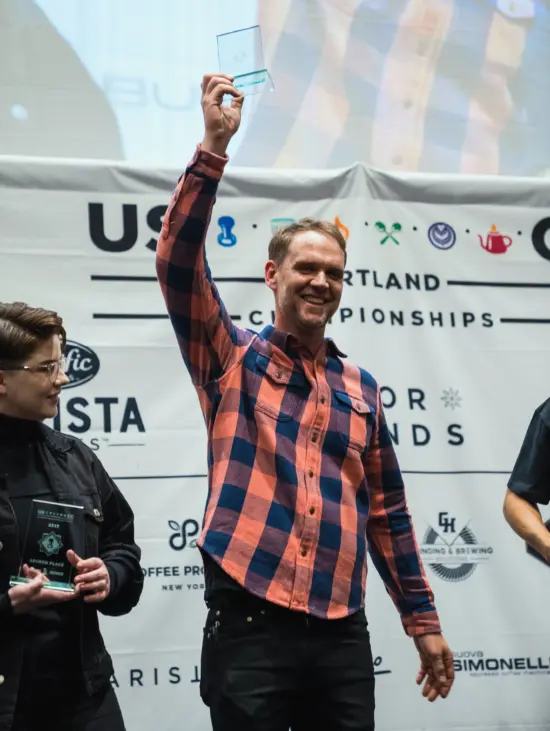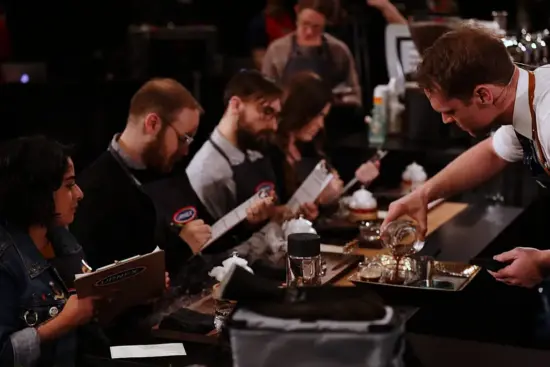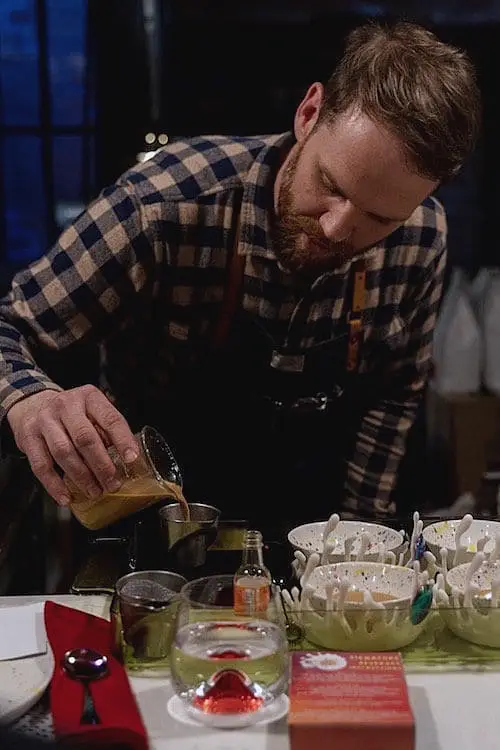Isaiah Sheese on Becoming the 2023 U.S. Barista Champion: Part One
The veteran competitor discusses the winning routine that helped him earn his first U.S. Barista Championship title.
BY CHRIS RYAN
BARISTA MAGAZINE ONLINE
Feature photo courtesy of Pacific Barista Series
For the last 15 years, Isaiah Sheese has been a mainstay in U.S. Barista competitions. The owner of Omaha, Neb.’s Archetype Coffee, Isaiah started competing in 2009, and has taken the stage at the U.S. Barista Championship (USBC) eight times. Before this year, Isaiah’s efforts resulted in one USBC finals appearance, when he finished fifth in 2020.
But at the 2023 USBC, Isaiah broke through. With stage decor and a routine inspired by painter Bob Ross and his mantra of “happy accidents,” and a collaborative coffee using a longtime Archetype producer and a unique processing method, Isaiah won the 2023 U.S. Barista Championship, which took place April 21-23 during the Specialty Coffee Expo in Portland, Ore.
In the first half of this two-part interview, we talk to Isaiah about his competition coffee, constructing his winning routine, and more.

Barista Magazine: For this year’s USBC, you used a Pink Bourbon grown by Lucy Fernanda Galindez at Finca Buena Vista, finished with a thermal shock process by Diego Bermudez of Finca El Paraiso. Most competitors making it far at USBC in recent years have been using Geshas, but you developed a “USBC-caliber” coffee through different means. Can you tell that story?
Isaiah Sheese: We’ve bought Lucy’s Pink Bourbon for four years through the La Muralla cooperative. We visited her in 2019, and her family cooked an amazing meal for us; they shared their lives with us, and it really left a mark. Lucy’s coffee has always scored well and kinda tastes like a Gesha, but a washed Pink Bourbon on the national stage is probably not going to compete against some of the other competition coffees.
So then during the pandemic we were trying to support roasters we like. Manhattan Coffee Roasters in Rotterdam, The Netherlands, was doing these really cool coffees. We found Diego Bermudez’s coffee through them and thought it was fantastic. It tasted like peaches—very clearly peaches. So then I just got to thinking: What if we got Diego to process Lucy’s coffee? So that’s what we ended up doing.
We’ve bought Lucy’s coffee through the importer Osito for four years, so I asked them to talk with Lucy to see if she’d be up for Diego processing her coffee, because I didn’t want to offend her. I didn’t want her to think that her coffee isn’t good enough; it’s just a different game in competition. But fortunately, she was OK with it. Lucy and her family picked the coffee, and then as soon as they’d sorted it, Jose from Osito loaded it up in his truck and drove three hours over the mountain to Diego’s farm to deliver it. It was a ton of work, and our partners helped us a lot.
Once we tasted Lucy’s coffee with Diego’s processing, I was like, we can do this. We can possibly win the USBC. But we’d be doing it the way we’ve always wanted to do it.

Diego’s processing method uses thermal shock; how does it work and why is it special?
It’s almost like a two-stage fermentation, with a thermal shock. It’s a fully washed coffee. First, they sanitize the cherry so they can control the fermentation. They put it in bioreactors for 48 hours at 65 degrees Fahrenheit at 20 psi. At the end of it, they collect all the juice that comes out of that first stage of the fermentation, and then they inoculate it with local bacteria and yeast at a specific ratio. He has specific strands he likes to use that he thinks create the best flavor. So then he pulps the coffee and takes all of the juice and those enzymes, and they repeat the process—48 hours, 65 degrees. But this time, they continue to increase the pressure throughout that secondary stage of fermentation.
Then, for his thermal shock process, he heats the bioreactor up to 105 degrees for 30 minutes. His theory is that it opens all the cellular walls of the coffee. And then he crashes it in 50 degree Fahrenheit water, locking in all the flavor. So, as I say in my talk, it’s basically like blanching vegetables. That’s kinda the same theory: You boil a vegetable for just a couple of seconds and then you drop it in the ice water and it locks in all the flavor.
Once you had your coffee in place, how did you build your routine around it?
My whole idea in the beginning was that I just wanted to talk about the scientific method. I thought that maybe I could prove every step of the way that if you make this choice, then you’re going to get that flavor. The problem with that idea was: it’s boring as crap (laughs). As great as the scientific method is, and I think a lot of people don’t really understand it, I knew it wasn’t going to communicate what I wanted it to.

And so then, “happy accidents” and Bob Ross popped in my head. I have no idea how—I don’t even know where it came from. The coffee itself is not a happy accident at all, but by applying the scientific method, we can prove it’s going to taste like this. And so it was trying to keep the presentation fun and whimsical but also very scientific, and to ride that line of both.
Freeze-distilled milk has been very popular in competition recently, but you used cryo-desiccated milk in your routine. Why?
Anthony Douglas gets the credit for the cryo-desiccated milk—he did it at the World Barista Championship last year and was kinda the first to do it. I chose it for its repeatability. Diego Bermudez’s processing is so controlled—he can repeat that process every time. We roasted our coffee on the Stronghold, and once you enter your profile it repeats it every time. And so the problem for me with freeze-distilled milk is that no matter how I did it, I felt like it was slightly different every time.
I wanted a process that was going to yield the same results. With the cryo-desiccation, you put the product in and the product comes out the same way every time. But also, with the cryo-desiccated milk, it seemed like there was more harmony with Lucy’s coffee. You could actually taste the peach and it didn’t get lost; it showcased her coffee, and that’s what we really wanted to do.
Stay tuned for the second half of this interview tomorrow.
Source: Barista Magazine



